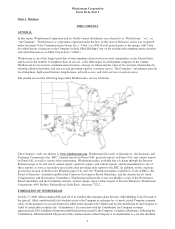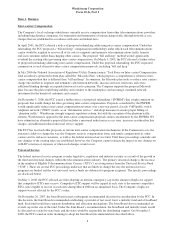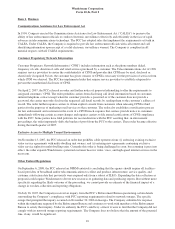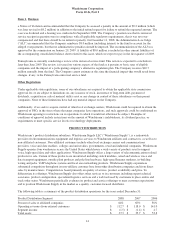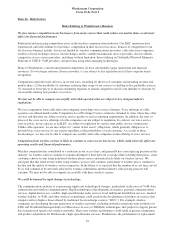Windstream 2008 Annual Report Download - page 56
Download and view the complete annual report
Please find page 56 of the 2008 Windstream annual report below. You can navigate through the pages in the report by either clicking on the pages listed below, or by using the keyword search tool below to find specific information within the annual report.
Windstream Corporation
Form 10-K, Part I
Item 1. Business
Inter-carrier Compensation
The Company’s local exchange subsidiaries currently receive compensation from other telecommunications providers,
including long distance companies, for origination and termination of interexchange traffic through network access
charges that are established in accordance with state and federal laws.
In April 2001, the FCC released a notice of proposed rulemaking addressing inter-carrier compensation. Under this
rulemaking, the FCC proposed a “bill and keep” compensation methodology under which each telecommunications
carrier would be required to recover all of its costs to originate and terminate telecommunications traffic from its
end-user customers rather than charging other carriers. The proposed “bill and keep” method would significantly
overhaul the existing rules governing inter-carrier compensation. On March 3, 2005, the FCC released a further notice
of proposed rulemaking addressing inter-carrier compensation. Under this proposed rulemaking, the FCC requested
comment on several alternative inter-carrier compensation proposals, including “bill and keep.”
In July 2006 the National Association of Regulatory Utility Commissioners’ Task Force on Inter-carrier Compensation
filed an industry-sponsored reform plan called the “Missoula Plan” which proposes a comprehensive reform to inter-
carrier compensation that is different than “bill and keep”. In summary, the Missoula plan seeks to reduce rates carriers
charge one another to originate and terminate calls between networks, increase end user retail rates and create
additional funding through an expanded universal service program. The Company supports the proposed Missoula
plan, because the plan would bring stability and certainty to the marketplace and encourage continued network
investment for the benefit of customers and carriers.
On November 5, 2008, the FCC issued a further notice of proposed rulemaking (“FNPRM”) that sought comment on
proposals that would change the rules governing inter-carrier compensation. Proposals considered by the FNPRM
would significantly reduce inter-carrier compensation revenues over a ten-year period, classify VoIP/public switch
telephone network (“PSTN”) traffic as an “information service,” and adopt measures to ensure proper billing of
“phantom traffic”. Windstream strongly supports regulatory reform, but with the exception of the phantom traffic
reforms, Windstream is opposed to the inter-carrier compensation proposals under consideration by the FNPRM. We
have submitted an alternative proposal that includes a measured reduction in access rates, increases in subscriber line
charges, and additional federal universal service support.
The FCC has received other proposals to reform inter-carrier compensation mechanisms. If the Commission acts, the
outcome is likely to change the way the Company receives compensation from, and remits compensation to, other
carriers and its end-user customers, as well as the federal universal service fund. Until these proceedings conclude and
any changes to the existing rules are established, however, the Company cannot estimate the impact of any changes on
its ILEC revenues or expenses or when such changes would occur.
Universal Service
The federal universal service program is under legislative, regulatory and industry scrutiny as a result of the growth in
the fund and structural changes within the telecommunications industry. The primary structural change is the increase
in the number of Eligible Telecommunications Carriers (“ETCs”) receiving money from the Universal Service Fund
(“USF”). There are several FCC proceedings underway that are likely to change the way the universal service
programs are funded and the way universal service funds are disbursed to program recipients. The specific proceedings
are discussed below.
On May 1, 2008, the FCC released an order adopting an interim, emergency cap on the amount of high-cost support
that competitive ETCs may receive. Competitive ETC support will be capped in each state at the amount competitive
ETCs were eligible to receive in such state during March 2008 on an annualized basis. The Company’s high-cost
support was not affected by the FCC’s order.
On November 20, 2007, the Joint Board issued a subsequent recommended decision for consideration by the FCC. In
this decision, the Joint Board recommended establishing a provider of last resort fund, a mobility fund and a broadband
fund. Each fund would have separate distribution and allocation mechanisms. The Joint Board also recommended an
overall cap in the size of the fund. Under the Joint Board’s recommendation, the broadband and mobility funds would
be allocated on a state-by-state basis and the states would be responsible for distributing support. On November 5,
2008, the FCC issued an order declining to adopt the Joint Board recommendations described above.
8






